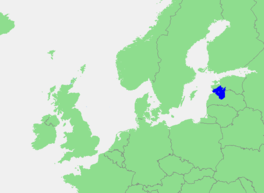Gulf of Riga
 From Wikipedia - Reading time: 7 min
From Wikipedia - Reading time: 7 min
| Gulf of Riga | |
|---|---|
 Location in Northern Europe. | |
| Location | Europe |
| Coordinates | 57°45′N 23°30′E / 57.750°N 23.500°E |
| Primary inflows | Daugava, Pärnu, Lielupe, Gauja, Salaca |
| Surface area | 18,000 km2 (6,900 sq mi) |
| Average depth | 26 m (85 ft) |
| Max. depth | 54 m (177 ft)[1] |
| Water volume | 424 km3 (344,000,000 acre⋅ft) |
| Residence time | 30 years |
| Frozen | Most or all during winter |
| Settlements | Riga, Jūrmala, Pärnu, Kuressaare, Salacgrīva, Saulkrasti, Ainaži |
The Gulf of Riga, Bay of Riga, or Gulf of Livonia (Latvian: Rīgas līcis, Estonian: Liivi laht, Livonian: Piški meŗ, lit. 'Small Sea')[2] is a bay of the Baltic Sea between Latvia and Estonia.
The island of Saaremaa (Estonia) partially separates it from the rest of the Baltic Sea. The main connection between the gulf and the Baltic Sea is the Irbe Strait.
The Gulf of Riga, as a sub-basin of the Baltic, also includes the Väinameri Sea in the West Estonian archipelago.
Geography
[edit]Extent
[edit]
The International Hydrographic Organization defines the Gulf of Riga's western limit as "A line running from Lyser Ort (57°34'N), in Latvia, to the South extreme of Saaremaa, through this island to Pammana (22°34'E), thence to Emmaste Point, the S extreme of Hiiumaa, through Hiiumaa to Tahkuna Point, the North extreme thereof, and on to Spithamn Point in Estonia".[3]
Islands
[edit]Major islands in the gulf include Saaremaa, Kihnu, and Ruhnu, which are all in Estonian territory. Kihnu covers an area of 16.4 square kilometres (6.3 sq mi).[4] Saaremaa island is responsible for the brackish water of the Gulf of Riga, as it is partially "shielded" from the Baltic Sea. The Baltic itself is already less salty than the global oceanic average, but this effect has a north–south and east–west gradient.[5][6]
Cities
[edit]Notable cities around the gulf include Riga and Jūrmala in Latvia, and Pärnu and Kuressaare in Estonia. The main rivers flowing into the gulf are Daugava, Pärnu, Lielupe, Gauja, and Salaca.
Salinity
[edit]The freshwater runoff entering the Baltic sea accounts for two percent of its volume.[4] A narrow connection to the North Sea means that water stays in the Baltic for an average of 30 years. These two characteristics work to make the Baltic Sea one of the largest brackish bodies of water in the world. The Gulf of Riga has an average salt concentration for the Baltic Sea, which is around six to ten parts per thousand. Freshwater has a concentration of 0.5 parts per thousand, and seawater is about 30 parts per thousand.[4]
Winter
[edit]In winter, most or all of the Bay occasionally freezes. This is due to low salinity and the calming effect of the partial closure of the entrance of the gulf. During the winter, many people walk over the bay. The thickest recorded ice was 90 centimetres (2 ft 11 in) thick in the winter of 1941–42.[7] Ice hole fishing has been a traditional source of winter food, and remains a common activity. The ice usually melts between March and April. In late March 2013, when the ice started to melt, 200 people had to be rescued from ice floes.[8]
See also
[edit]References
[edit]- ^ "Gulf of Riga | Baltic Sea". Encyclopedia Britannica.
- ^ "Old Kolka lighthouse". visit.dundaga.lv. Retrieved 20 July 2023.
- ^ "Limits of Oceans and Seas, 3rd edition" (PDF). International Hydrographic Organization. 1953. Archived from the original (PDF) on 8 October 2011. Retrieved 28 December 2020.
- ^ a b c C.Michael Hogan. 2011. Gulf of Riga. Encyclopedia of Earth. Eds. P.Saundry & C.J.Cleveland. National Council for Science and the Environment. Washington DC.
- ^ Kniebusch, Madline; Meier, H.E. Markus; Radtke, Hagen (2019). "Changing Salinity Gradients in the Baltic Sea as a Consequence of Altered Freshwater Budgets". Geophysical Research Letters. 46 (16): 9739–9747. Bibcode:2019GeoRL..46.9739K. doi:10.1029/2019GL083902. S2CID 199856860.
- ^ Lehmann, Andreas; Myrberg, Kai; Post, Piia; Chubarenko, Irina; Dailidiene, Inga; Hinrichsen, Hans-Harald; Hüssy, Karin; Liblik, Taavi; Meier, H. E. Markus; Lips, Urmas; Bukanova, Tatiana (2022). "Salinity dynamics of the Baltic Sea". Earth System Dynamics. 13 (1): 373–392. Bibcode:2022ESD....13..373L. doi:10.5194/esd-13-373-2022. S2CID 246912171.
- ^ "Estonica.org - The Gulf of Riga". www.estonica.org.
- ^ Riga, Associated Press in (29 March 2013). "Latvia rescues 220 people stranded on ice floes in Gulf of Riga". the Guardian.
External links
[edit]- The Gulf of Riga Archived 12 August 2021 at the Wayback Machine (Estonica)
 KSF
KSF